Flexible Chitosan-Based Capacitive Humidity Sensors for Respiratory Monitoring
Abstract
:1. Introduction
2. Materials and Methods
2.1. Flexible Interdigital Electrode Substrate Preparation
2.2. Preparation of Chitosan-Based Sensor
2.3. Experimental Setup
3. Results and Discussion
3.1. Capacitive Humidity Sensor
3.2. Respiratory Monitoring System Testing
3.3. Speech Recognition Testing
4. Conclusions
Author Contributions
Funding
Institutional Review Board Statement
Informed Consent Statement
Data Availability Statement
Conflicts of Interest
References
- Liu, L.; Shah, S.; Zhao, G.; Yang, X. Respiration symptoms monitoring in body area networks. Appl. Sci. 2018, 8, 568. [Google Scholar] [CrossRef]
- Siam, A.I.; El-Bahnasawy, N.A.; El Banby, G.M.; Abou Elazm, A.; Abd El-Samie, F.E. Efficient video-based breathing pattern and respiration rate monitoring for remote health monitoring. J. Opt. Soc. Am. A 2020, 37, C118–C124. [Google Scholar] [CrossRef] [PubMed]
- Zhu, K.; Li, M.; Akbarian, S.; Hafezi, M.; Yadollahi, A.; Taati, B. Vision-based contactless respiratory rate monitoring during sleep. Sleep. Med. 2019, 64, S428. [Google Scholar] [CrossRef]
- Maurya, L.; Mahapatra, P.; Chawla, D. Non-contact breathing monitoring by integrating RGB and thermal imaging via RGB-thermal image registration. Biocybern. Biomed. Eng. 2021, 41, 1107–1122. [Google Scholar] [CrossRef]
- Kan, Y.; Meng, J.; Guo, Y.; Li, X.; Gao, D. Humidity sensor based on cobalt chloride/cellulose filter-paper for respiration monitoring. J. Electroanal. Chem. 2021, 895, 115423. [Google Scholar] [CrossRef]
- Lu, Y.; Yang, G.; Shen, Y.; Yang, H.; Xu, K. Multifunctional flexible humidity sensor systems towards noncontact wearable electronics. Nano Micro Lett. 2022, 14, 150. [Google Scholar] [CrossRef]
- Kano, S.; Jarulertwathana, N.; Mohd-Noor, S.; Hyun, J.K.; Asahara, R.; Mekaru, H. Respiratory monitoring by ultrafast humidity sensors with nanomaterials: A review. Sensors 2022, 22, 1251. [Google Scholar] [CrossRef]
- Liang, Y.; Ding, Q.; Wang, H.; Wu, Z.; Li, J.; Li, Z.; Tao, K.; Gui, X.; Wu, J. Humidity sensing of stretchable and transparent hydrogel films for wireless respiration monitoring. Nano Micro Lett. 2022, 14, 183. [Google Scholar] [CrossRef]
- Song, Z.; Li, S.; Hou, B.; Cheng, Z.; Xue, Y.; Chen, B. High-sensitivity paper-based capacitive humidity sensors for respiratory monitoring. IEEE Sens. J. 2023, 23, 2291–2302. [Google Scholar] [CrossRef]
- Su, P.G.; Wang, C.S. Novel flexible resistive-type humidity sensor. Sens. Actuators B 2007, 123, 1071–1076. [Google Scholar] [CrossRef]
- Dokmeci, M.; Najafi, K. A high-sensitivity polyimide capacitive relative humidity sensor for monitoring anodically bonded hermetic micropackages. J. Microelectromech. Syst. 2001, 10, 197–204. [Google Scholar] [CrossRef]
- Tong, X.; Wang, X. A novel surface acoustic wave humidity sensor. Micronanoelectron. Technol. 2014, 51, 115–119. [Google Scholar] [CrossRef]
- Ascorbe, J.; Corres, J.M.; Arregui, F.J.; Matias, I.R. Recent developments in fiber optics humidity sensors. Sensors 2017, 17, 893. [Google Scholar] [CrossRef] [PubMed]
- Yu, X.; Chen, X.; Yu, X.; Chen, X.; Ding, X. A quartz crystal microbalance (QCM) humidity sensor based on a pencil-drawn method with high quality factor. IEEE Trans Electron. Devices 2021, 68, 5149–5154. [Google Scholar] [CrossRef]
- Chakraborty, S.; Hara, K.; Lai, P.T. New microhumidity field-effect transistor sensor in ppmv level. Rev. Sci. Instrum. 1999, 70, 1565–1567. [Google Scholar] [CrossRef]
- Alqarni, S.A.; Hussein, M.A.; Ganash, A.A.; Khan, A. Composite material-based conducting polymers for electrochemical sensor applications: A mini review. BioNanoScience 2020, 10, 351–364. [Google Scholar] [CrossRef]
- Blank, T.A.; Eksperiandova, L.P.; Belikov, K.N. Recent trends of ceramic humidity sensors development: A review. Sens. Actuators B 2016, 228, 416–442. [Google Scholar] [CrossRef]
- Nasution, T.I.; Nainggolan, I.; Dalimunthe, D.; Balyan, M.; Cuana, R.; Khanifah, S. Humidity detection using chitosan film based sensor. IOP Conf. Ser. Mater. Sci. Eng. 2018, 309, 012080. [Google Scholar] [CrossRef]
- Wang, S.; Yan, H.; Zheng, H.; He, Y.; Guo, X.; Li, S.; Yang, C. Fast response humidity sensor based on chitosan/graphene oxide/tin dioxide composite. Sens. Actuators B 2023, 392, 134070. [Google Scholar] [CrossRef]
- Kumari, P.; Kumar, A.; Yadav, A.; Gupta, G.; Gupta, G.; Shivagan, D.D.; Bapna, K. Chitosan-based highly sensitive viable humidity sensor for human health monitoring. ACS Omega 2023, 8, 39511–39522. [Google Scholar] [CrossRef]
- JZikulnig, J.; Lengger, S.; Rauter, L.; Neumaier, L.; Carrara, S.; Kosel, J. Sustainable Printed Chitosan-Based Humidity Sensor on Flexible Biocompatible Polymer Substrate. IEEE Sens. Lett. 2022, 6, 12. [Google Scholar] [CrossRef]
- Park, S.-J.; Kim, M.-H.; Ha, T.-J. All-printed wearable humidity sensor with hydrophilic polyvinylpyrrolidone film for mobile respiration monitoring. Sens. Actuators B Chem. 2023, 394, 134395. [Google Scholar] [CrossRef]
- Duan, Z.; Jiang, Y.; Tai, H. Recent advances in humidity sensors for human body related humidity detection. J. Mater. Chem. C 2021, 9, 14963. [Google Scholar] [CrossRef]



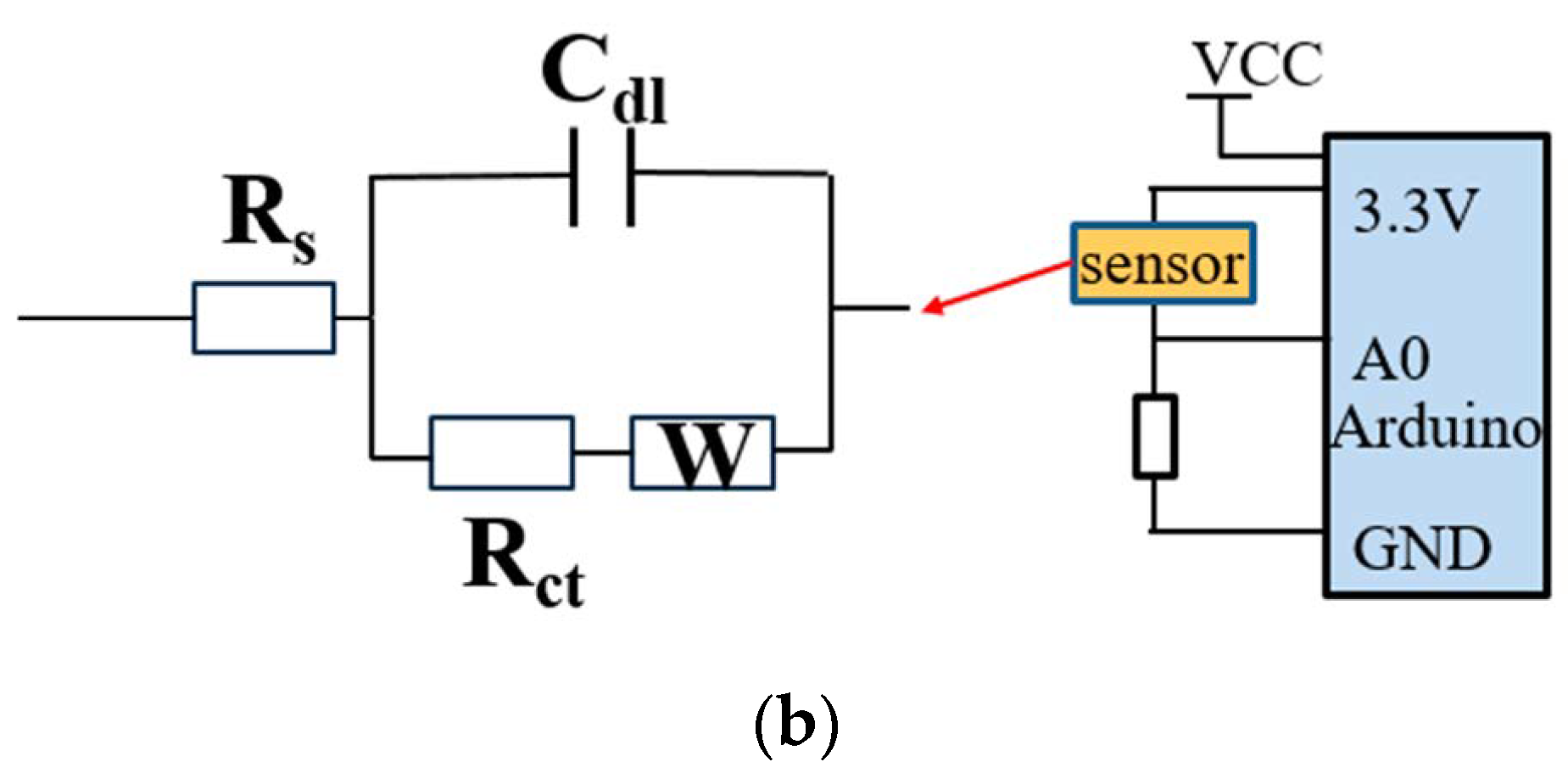
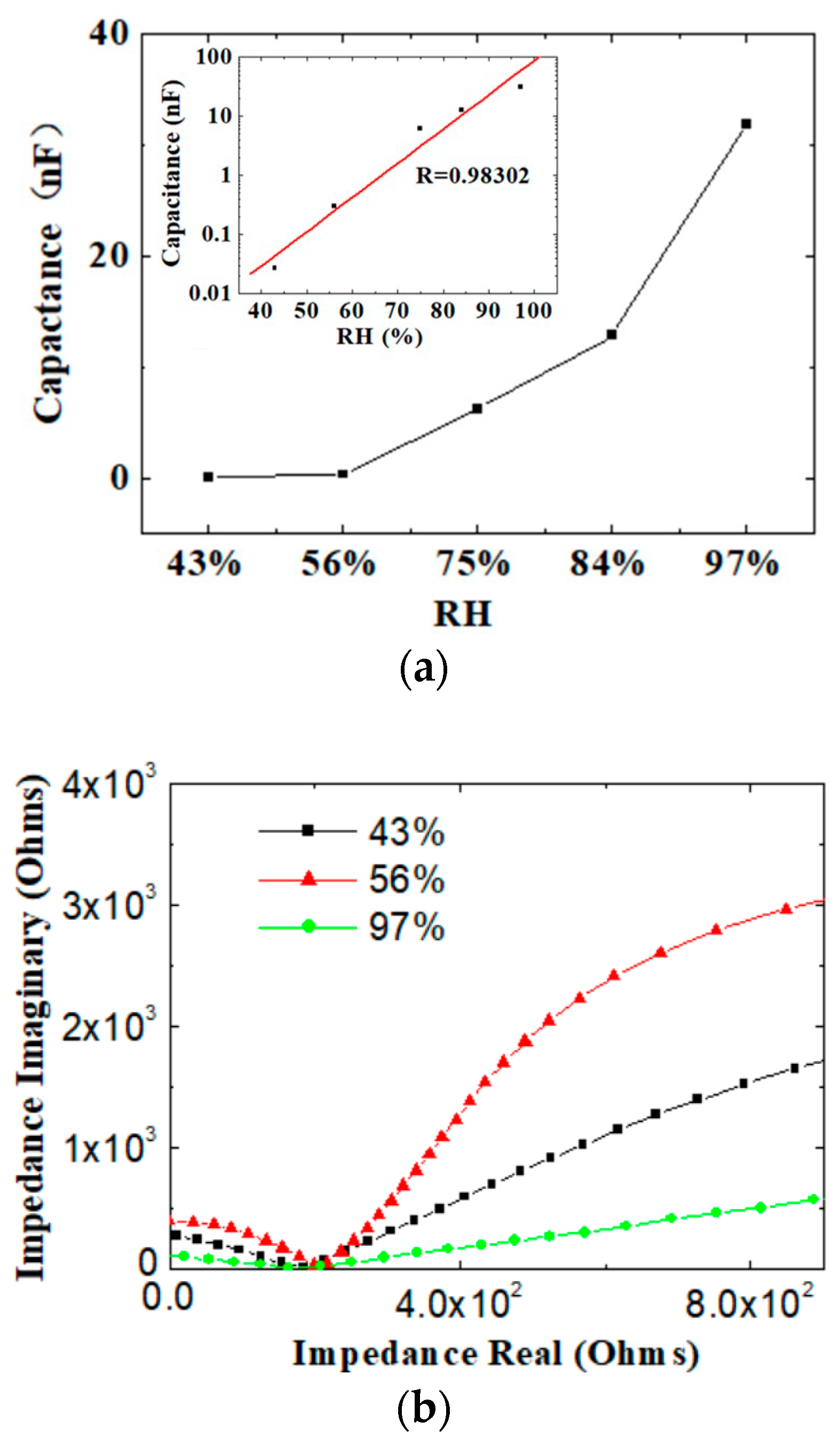
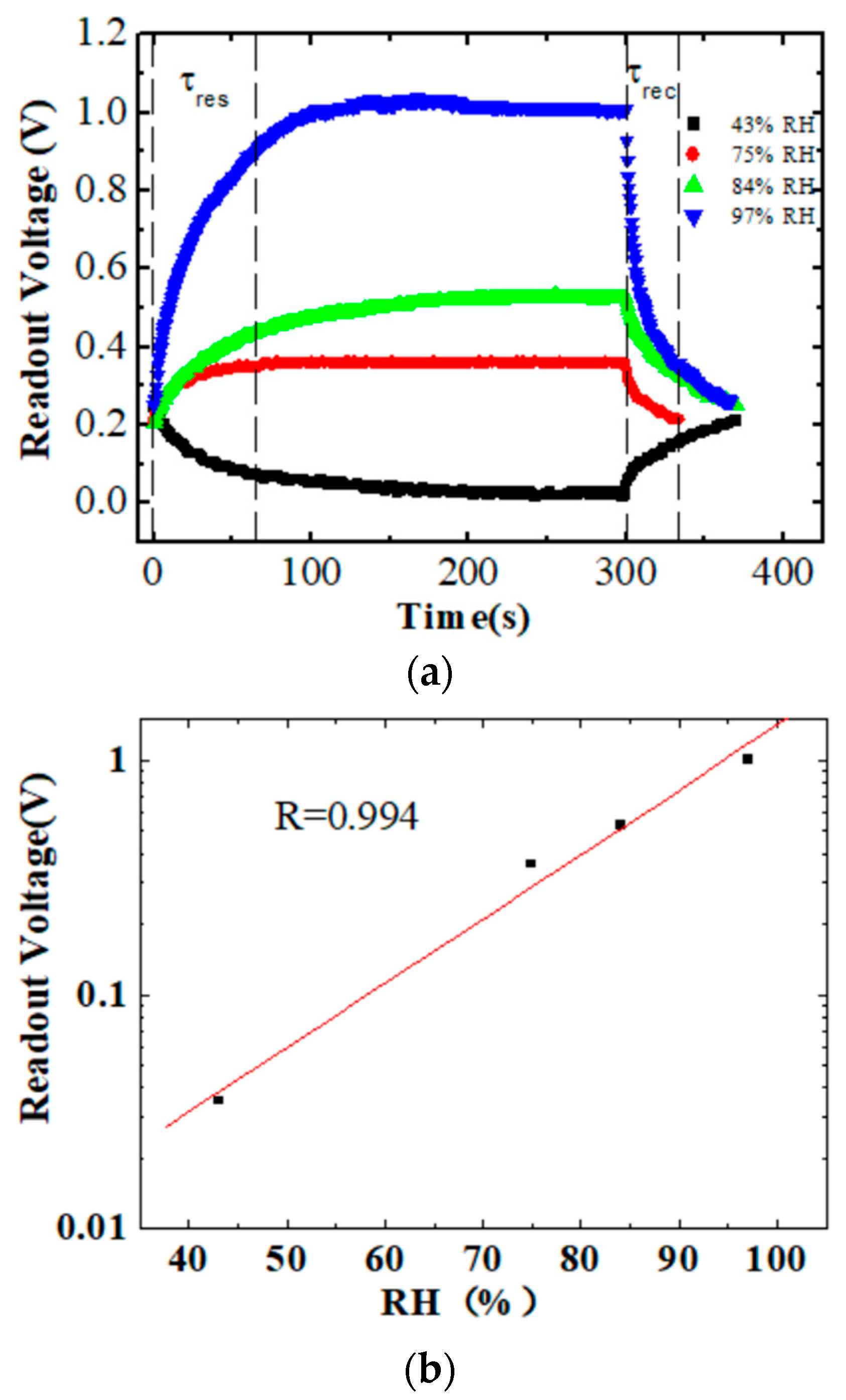
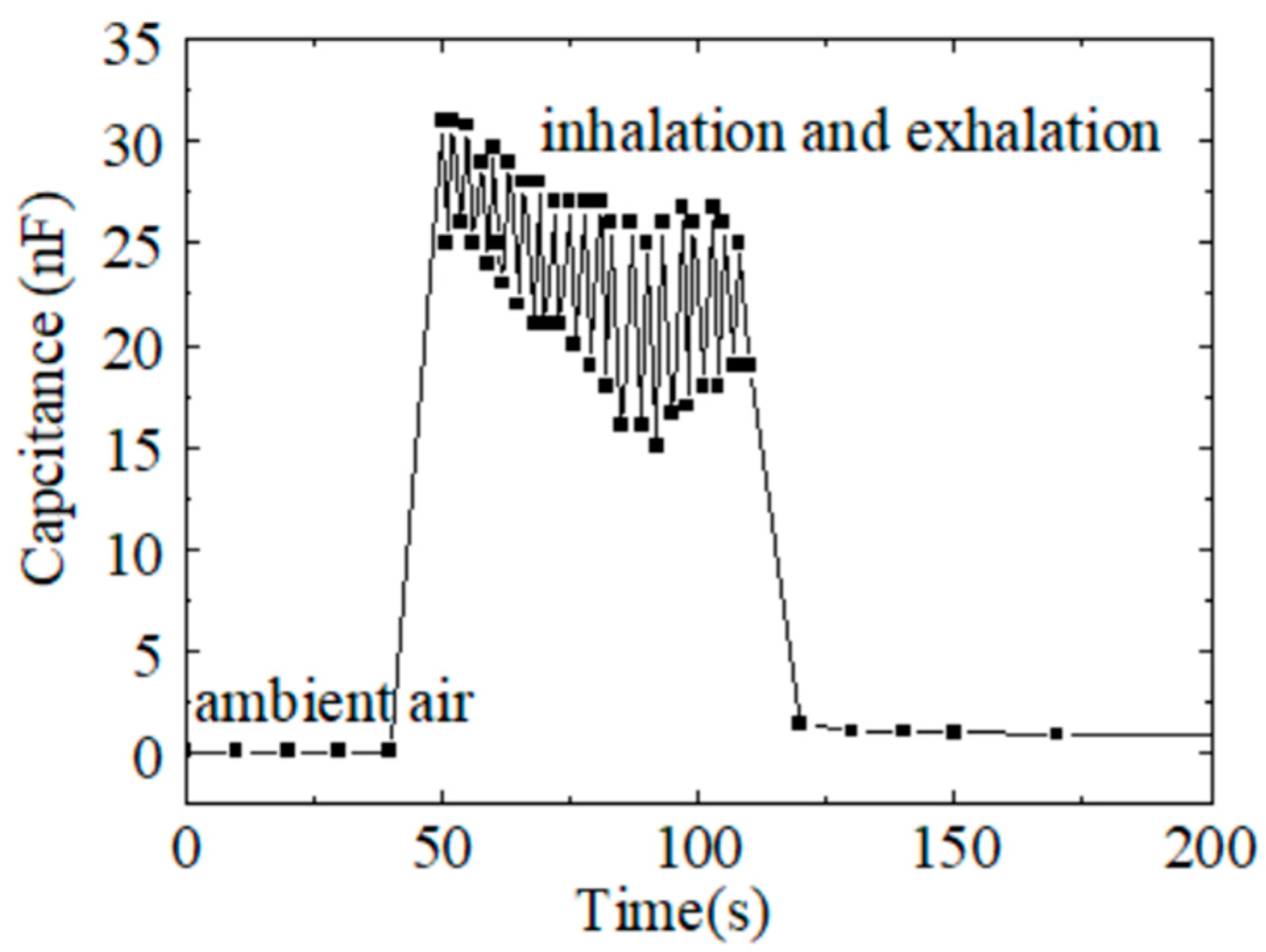
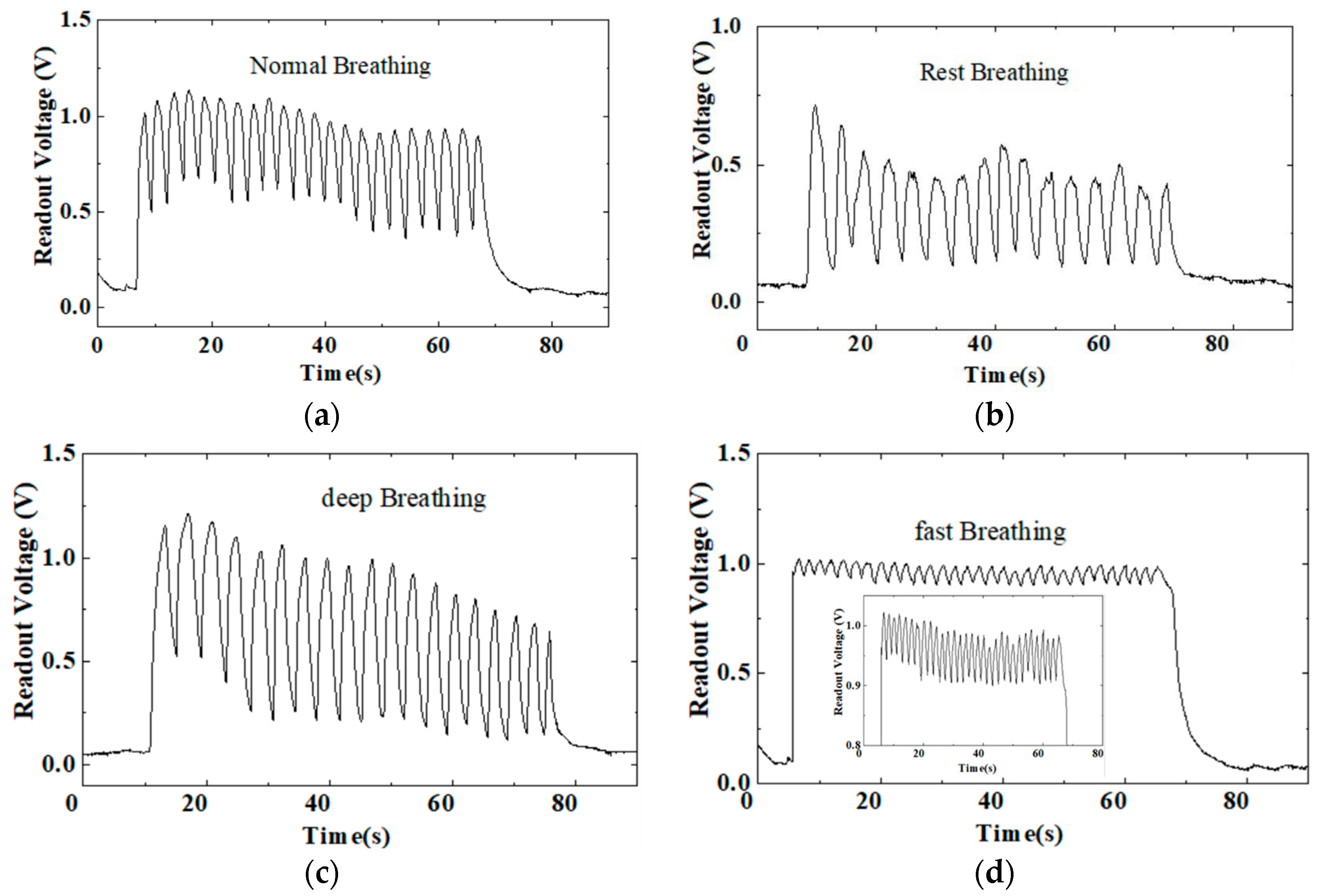

Disclaimer/Publisher’s Note: The statements, opinions and data contained in all publications are solely those of the individual author(s) and contributor(s) and not of MDPI and/or the editor(s). MDPI and/or the editor(s) disclaim responsibility for any injury to people or property resulting from any ideas, methods, instructions or products referred to in the content. |
© 2024 by the authors. Licensee MDPI, Basel, Switzerland. This article is an open access article distributed under the terms and conditions of the Creative Commons Attribution (CC BY) license (https://creativecommons.org/licenses/by/4.0/).
Share and Cite
Pan, M.; Zhou, J.; Weng, S.; Wu, X. Flexible Chitosan-Based Capacitive Humidity Sensors for Respiratory Monitoring. Sensors 2024, 24, 1352. https://doi.org/10.3390/s24051352
Pan M, Zhou J, Weng S, Wu X. Flexible Chitosan-Based Capacitive Humidity Sensors for Respiratory Monitoring. Sensors. 2024; 24(5):1352. https://doi.org/10.3390/s24051352
Chicago/Turabian StylePan, Miaoxin, Jumei Zhou, Shichen Weng, and Xingjian Wu. 2024. "Flexible Chitosan-Based Capacitive Humidity Sensors for Respiratory Monitoring" Sensors 24, no. 5: 1352. https://doi.org/10.3390/s24051352
APA StylePan, M., Zhou, J., Weng, S., & Wu, X. (2024). Flexible Chitosan-Based Capacitive Humidity Sensors for Respiratory Monitoring. Sensors, 24(5), 1352. https://doi.org/10.3390/s24051352




